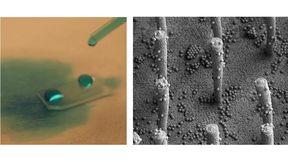Defence of dissertation in the field of applied physics, M.Sc. Anas Al-Azawi

When
Where
Event language(s)
The property of repelling water droplets is a well-known phenomenon. The wings of cicada insect and the lotus leaves exhibit extreme non-wettability. Water droplets roll off easily collecting dirt and contaminants. Thus these surfaces are kept dry and clean. This self-cleaning property is attributed to surface micro- and nanostructures combined with low surface energy chemistry. Extreme-non-wettable surfaces are commonly known as superhydrophobic surfaces. This topic has captured the attention of material science communities due to the potential of producing surfaces with properties such as self-cleaning, drag reduction, anti-fogging, to name a few. Research on superhydrophobicity can solve problems associated with liquid accumulation on surfaces and therefore is important for industrial applications such as solar cells and medical devices. Accurate characterization of superhydrophobic surfaces is essential for the development of the field because it provides correlation between surface topography and surface energy to the measured degree of superhydrophobicity.
In this work oscillating droplet tribometer was utilized for the characterization of silicon micropillared superhydrophobic surfaces. Freely decaying droplet oscillations were captured and analyzed to reveal the relation between dissipative forces and surface parameters. Remarkably, every variation in pattern density or in chemical modification was probed successfully. This is in contrast to contact angle measurements, which cannot distinguish between surfaces that have comparable degree of superhydrophobicity. In addition to superhydrophobic structures made of silicon, magnetically responsive micropillars were fabricated. These flexible micropillars mimic the biological cilia and can induce directional droplet motion by magnetic actuation.
The use of thiol-ene for synthesizing the magnetic micropillars enabled tuning the surface as well as the elastic properties. Functionalizing the surface with colloidal micro- and nanoparticles enhanced the stability and superhydrophobicity of the high aspect ratio micropillars. This allowed the actuation of the durable magnetic micropillars in air. Engineering structures with customizable properties like responsive properties can advance the field of superhydrophobic surfaces. Cilia-inspired magnetic structures have prominent applications including mixing and fluid flow sensing in microfluidic devices as well as interfacing with biomatter in medical devices.
Opponent is Professor Rafael Taboryski, Technical University of Denmark, Denmark
Custos is Professor Robin Ras, Aalto University School of Science, Department of Applied Physics
Contact details of the doctoral candidate: Anas Al-Azawi, [email protected], +358504380699
The public defence will be organised via Zoom. Link to the event
The dissertation is publicly displayed 10 days before the defence in the publication archive Aaltodoc of Aalto University.